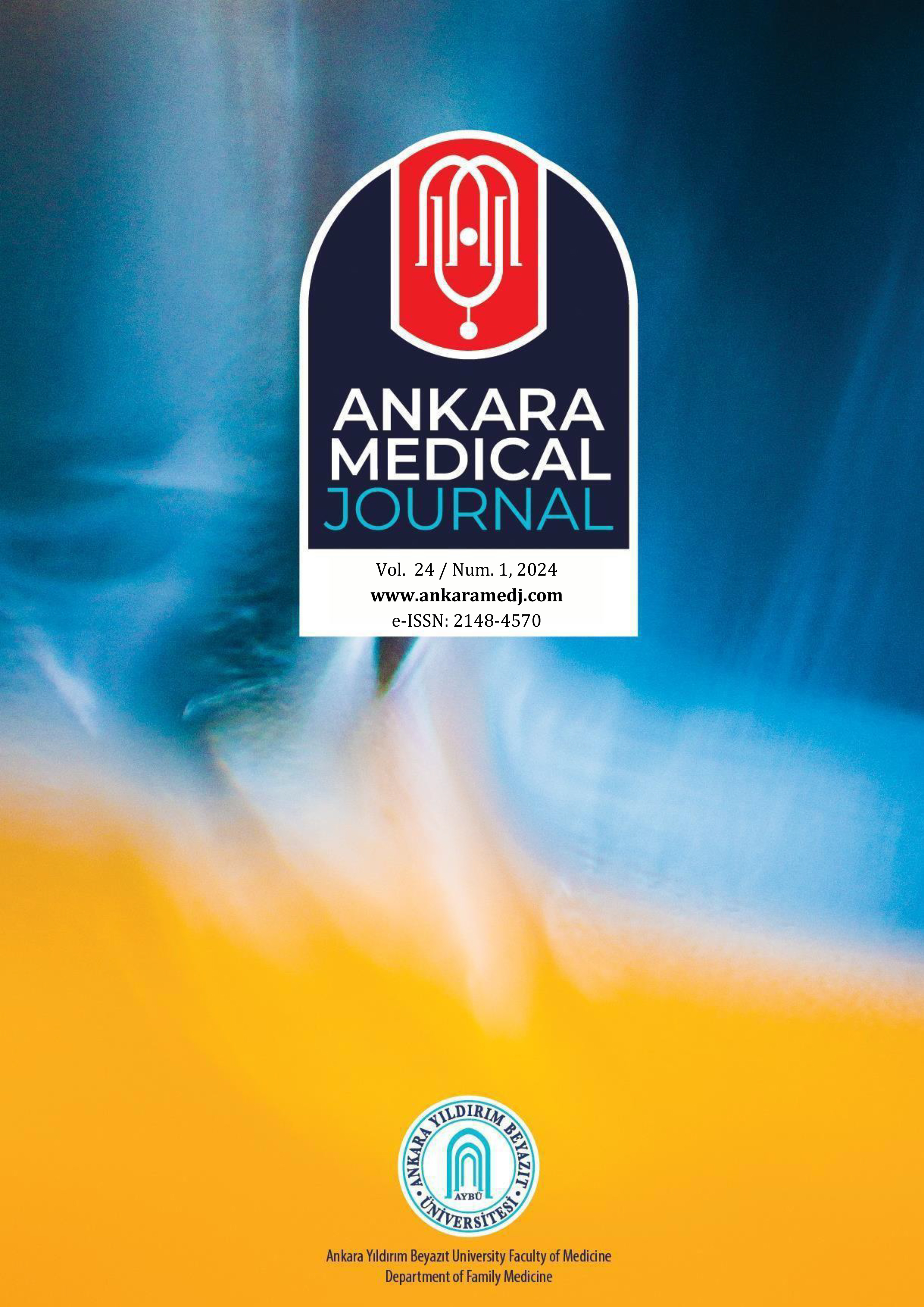Bozulmuş açlık glukozu olan kadın hastalarda fibromiyalji sıklığı: Kesitsel çalışma
Ayla Cagliyan Turk1, SEVİL OKAN2, SUMRU OZEL3, Ahmet Musmul4, Murat Baglicakoglu5, ferit kerim kucukler6, FÜSUN SAHIN71Hitit Üniversitesi, Tıp Fakültesi, Fiziksel Tıp Ve Rehabilitasyon Anabilim Dalı, Çorum, Türkiye.2Tokat Devlet Hastanesi, Fiziksel Tıp Ve Rehabilitasyon Kliniği, Tokat, Türkiye.
3Ankara Fizik Tedavi Ve Rehabilitasyon Hastanesi, Fiziksel Tıp Ve Rehabilitasyon Anabilim Dalı, Ankara, Türkiye.
4Osmangazi Üniversitesi, Sağlık Hizmetleri Meslek Yüksekokulu, Tıbbi Hizmetler Ve Teknikler Anabilim Dalı, Eskişehir, Türkiye.
5Çorum Özel Hastanesi, İç Hastalıkları, Çorum, Türkiye
6Memorial Hastanesi, Endokrinoloji Kliniği, İstanbul, Türkiye.
7Pamukkale Üniversitesi, Tıp Fakültesi, Fiziksel Tıp Ve Rehabilitasyon Anabilim Dalı,denizli, Türkiye.
GİRİŞ ve AMAÇ: Bozulmuş açlık glukozu olan kadınlarda fibromiyalji sıklığını değerlendirmek.
YÖNTEM ve GEREÇLER: Dahiliye polikliniğine nonspesifik nedenlerle başvuran kadınlar arasından, rutin muayenesinde açlık kan şekeri düzeyi 100-126 olanlar çalışma grubunu (Grup 1) ve açlık kan şekeri değeri 100'den küçük olanlar kontrol grubunu oluşturdu (Grup 2). Bozulmuş açlık glukozu (BAG) olan hastalara (Grup 1) oral glukoz tolerans testi (OGTT) yaptırıldı ve 2. Saat OGTT değeri 140ın altında olan hastalar çalışmaya dahil edildi. Fibromiyalji Etki Anketi (FIQ) kullanılarak fonksiyonel durum değerlendirildi. Fibromiyalji tanısı için ağrı yerleşim skoru (AYS) ve semptom etkilenme skorlaması (SES) değerlendirildi.
BULGULAR: Ortalama yaş Grup 1'de 48.99 ± 7.50 (n = 73) ve Grup 2'de 47.84 ± 7.92 idi (n = 73), aralarında anlamlı fark yoktu. Ortalama VKİ (vücut kitle indeksi) Grup 1'de 30.41 ± 5.01, Grup 2'de 28.00 ± 4.61 idi, aradaki fark anlamlıydı (p <0.05). Gruplar mesleki durum, eğitim yılı, medeni durum bakımından benzerdi. Grup 1'deki hastaların% 26'sına, Grup 2'deki hastaların% 11'ine fibromiyalji tanısı kondu ve aradaki fark anlamlıydı (p <0.001). Ortalama FIQ Grup 1'de 44.27 ± 21.98 ve Grup 2'de 24.95 ± 21.49 idi, aradaki fark anlamlıydı (p <0.001). Glukoz düzeyi, AYS (r = 0.368, p <0.001), SES (r = 0.322 p <0.001) ve FIQ (r = 0.287, p <0.001) ile ilişkiliydi.
TARTIŞMA ve SONUÇ: Fibromiyalji, bozulmuş açlık glukozu bozuk olan kadın hastalarda, açlık glukoz düzeyi normal olanlara göre daha yaygındır. Glukoz düzeyi AYS, SES ve fonksiyonellik ile ilişkilidir. Klinik bir hastalık olmasa da bozulmuş açlık glukozu sadece diyabet gelişimi için bir risk faktörü değil aynı zamanda kadınlarda fibromiyalji için bir risk faktörüdür.
The frequency of fibromyalgia in female patients with impaired fasting blood glucose: Cross-sectional study
Ayla Cagliyan Turk1, SEVİL OKAN2, SUMRU OZEL3, Ahmet Musmul4, Murat Baglicakoglu5, ferit kerim kucukler6, FÜSUN SAHIN71Hitit University, Faculty Of Medicine, Department Of Physical Medicine And Rehabilitation, Corum, Turkey.2Department Of Physical Medicine And Rehabilitation, Tokat Goverment Hospital, Tokat, Turkey.
3Department Of Physical Medicine And Rehabilitation, Ankara Physical Therapy And Rehabilitation Training And Research Hospital, Ankara, Turkey.
4Department Of Medical Services And Techniques, Vocational School Of Health Services, Osmangazi University, Eskisehir, Turkey.
5Department Of Internal Medicine, Corum Private Hospital, Corum, Turkey.
6Department Of Endocrinology, Memorial Hospital, Istanbul, Turkey.
7Department Of Physical Medicine And Rehabilitation, Faculty Of Medicine, Pamukkale University, Denizli, Turkey.
INTRODUCTION: To assess the frequency of fibromyalgia among women with impaired fasting glucose.
METHODS: The sample was selected from the female patients who applied to the Internal Medicine clinic and whose fasting blood glucose level were 100-126 in their routine examination (Group1) and patients whose fasting blood glucose were less than 100 constituted the control group (Group2). Oral glucose tolerance test (OGTT) has been applied to patients with impaired fasting glucose (IFG) and whose 2nd hour OGTT levels were under 140 has been included. Functional status was assessed by using the Fibromyalgia Impact Questionnaire (FIQ). Pain Location Inventory (PLI), and Symptom Impact Questionnaire (SIQR) were evaluated for the diagnosis of fibromyalgia.
RESULTS: Mean age was 48.99±7.50 in Group1 (n=73) and 47.84±7.92 in Group2 (n=73) with no significant difference between them. Mean BMI (body mass index) was 30.41±5.01 in Group1 and 28.00±4.61in Group2, this difference was significant (p<0.05). 26% of the patients in Group1, 11% of the patients in Group2 were diagnosed with fibromyalgia and difference was highly significant (p<0.001). Mean FIQ was 44.27±21.98 in Group1 and 24.95±21.49 in Group2, this difference was also significant (p<0.001). Glucose level was associated with PLI (r=0.368, p<0.001), SIQR (r=0.322 p<0.001) and FIQ (r= 0.287, p<0.001).
DISCUSSION AND CONCLUSION: Fibromyalgia is more prevalent in female patients with IFG than in patients with normal fasting glucose levels. Glucose level is associated with both PLI, SIQR and functionality. Although not a clinical disease, IFG is not only a risk factor for development of diabetes but also a risk factor for fibromyalgia in women.
Sorumlu Yazar: Ayla Cagliyan Turk, Türkiye
Makale Dili: İngilizce
(798 kere indirildi)





